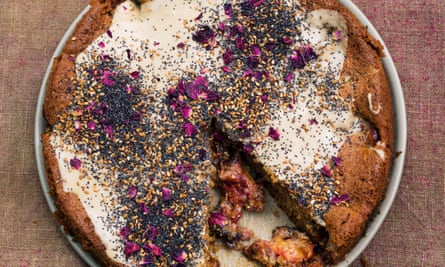Now, for the crimson and golden plums – the ‘Czar’ and ‘Marjorie’s Seedling’, the ‘Opal’ and then ‘Victoria’ (she’s at her best when fully ripened, so beads of nectar gather at the tip).
Even for breakfast, cooked till they have softened enough to crush effortlessly between finger and thumb, their syrup shot with glowing ruby, plums appreciate a dusting of spice: ground ginger perhaps, cinnamon definitely. I give them cardamom, too – the black seeds tweaked out of their green pods and ground to a grey dust.
Plums will cook to a golden jelly in a cake, but are best in one made with the darker sugars, such as light or dark muscovado, and to which you have added ground ginger or mixed spice. The sugar’s butterscotch notes serve the fruit well.
With a plum cake baking, there was an excuse to roast onions while the oven was warm. A bit early perhaps, but I am eager to get to autumn food. I cooked them with butter, thyme and olive oil, leaving them soft and gold, their flesh translucent. (Left for long enough they will caramelise a little, too.) The smell of them roasting put me into autumn gear, piling them on top of a silky pool of polenta into whose golden depths I let cheese soften and melt.
Soft cheese polenta with roast onions
A soft, almost soupy polenta to eat with roasted onions. I sometimes add 100ml of double cream, warmed in a small saucepan, to the polenta. I use Tunworth or other soft cheese to finish. Camembert will do.
Serves 4
For the onions:
onions 4, medium-sized
olive oil 50g
butter 60g
thyme sprigs 10
For the polenta:
water 500ml
full-cream milk 500ml
fine polenta 150g
butter 50g
parmesan 100g, finely grated
soft cheese to finish 200g
Directions
Set the oven at 200C/gas mark 6. Peel the onions, halve them then cut each half in two. Put them in a roasting tin, trickle the oil over them, dot with butter and a few sprigs of thyme then bake for 20-30 minutes till golden and soft, basting from time to time.
Make the polenta. Pour the water and milk into a large, deep pan and place over a moderate heat. Bring the mixture to the boil, then salt generously. Rain the polenta into the liquid in a steady stream, stirring continuously. Take great care that the mixture doesn’t bubble and spit at you (it can be like a volcano). Lower the heat as necessary.
Keep stirring over the heat for a good 20 minutes until the mixture is smooth, creamy but not too thick. Beat the butter into the polenta.
Stir the grated parmesan into the polenta. (At this point you could add a little warmed cream.) Add salt and black pepper to taste. Spoon the polenta into warm dishes and top with the baked onions. Place the cheese on top of the onions and let it soften.

Wholemeal plum cake, spiced frosting
Serves 8
For the cake:
butter 200g
light muscovado sugar 75g
golden caster 75g
hazelnuts 100g, skinned
plums 500g, medium-sized
eggs 4
self-raising wholemeal flour 150g
baking powder 1 tsp
ground cinnamon ½ tsp
salt a pinch
For the icing:
icing sugar 150g
lemon juice 3 tsp
ground cinnamon a pinch
cardamom pods 6
sesame seeds 2 tsp
poppy seeds 2 tsp
dried rose petals 2 tsp
Directions
Set the oven at 160C/gas mark 3. Line the base of a 22cm spring-form baking tin. Dice the butter and put it in a food mixer with the sugars and beat for 5 minutes, till light and fluffy – the colour of latte. Regularly push the mixture down from the sides of the bowl with a rubber spatula to ensure even creaming.
While the butter and sugar cream, toast the hazelnuts in a dry pan, watching carefully and moving them round the pan so they colour evenly. Grind to a fine powder in a food processor. Cut the plums in half and discard their stones.
Beat the eggs lightly with a fork then add, slowly, with the paddle turning, to the butter and sugar. Combine the flour, baking powder, cinnamon, salt and the ground hazlenuts, then add to the batter, mixing it together thoroughly. Scrape the batter into the lined cake tin and gently smooth the surface.
Place the plums evenly on the surface of the cake. You want them to sink into the body of the cake as it bakes. Bake for 50–60 minutes till the cake is spongy to the touch. (Test for doneness after 50 minutes with a metal skewer: it should come out without any uncooked cake mixture sticking to it.)
Remove the cake from the oven and leave to settle for 20 minutes. Run a palette knife around the inside of the tin to the loosen the cake, then undo the tin and place on a plate.
Make the icing: sieve the icing sugar into a bowl, stir in the lemon juice, adding a little water if required to bring it to a thick, pouring consistency. Stir in the ground cinnamon. Crack open the cardamom pods, remove the seeds and grind them to a fine powder. Stir into the icing. Lightly toast the sesame seeds in a dry pan till golden, then mix them with the poppy seeds and rose petals.
Transfer the cake to a plate, then trickle the spiced icing over the surface. Scatter with the poppy seeds and rose petals.
Email Nigel at nigel.slater@observer.co.uk or follow him on Twitter @NigelSlater
